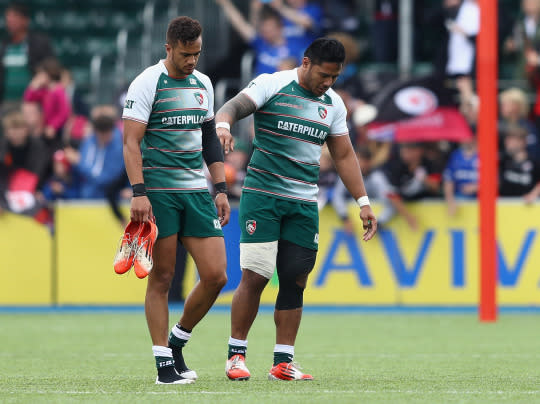Manu Tuilagi’s constant injuries could be a ‘nutritional problem’
Manu Tuilagi has spent a significant amount of time out injured throughout his professional career. As frustrating as it must be for his coaches, club medics and fans alike, nobody must be more irritated than Tuilagi himself.
Since returning to the field in January after a 15-month lay-off with a chronic groin injury, Tuilagi has been sidelined a further three times in four months, and a nutritional expert believes that the constant injuries are “100% a nutritional problem” and that “no amount of strength & conditioning work will keep Manu on the field”.
Speaking at the Rugby Innovation Summit in May, James Brown of DNActiv8 told The Rugby Pod how he had helped Sam Stanley of England Sevens, revive his injury struck career by redesigning his diet.
Stanley had been injured repeatedly during six seasons of professional sevens rugby, but after working with Brown and having a DNA sample analyzed, his personal nutritional needs and flaws in his diet became much clearer. Since then, Sam completed his first injury free season in his professional career – something Tuilagi has not managed since making his debut for England.

Although Brown doesn’t know the finer details of Tuilagi’s current diet, he believes a similar approach could help Tuilagi deal with his injury woes. He underlined that Stanley is similar to Tuilagi in the sense that they are both young, both of Samoan heritage, and most importantly both almost constantly injured.
Using DNA analysis, Brown works out how your body breaks down nutrients and reacts to different sugars, proteins and carbohydrates. He argues that DNA provides a “nutritional blue print” and is a major factor in how a rugby player’s body should be fueled. He explains that inflammation in the bones and muscles can be caused by the body’s ability to break down carbohydrates; “Some athletes can consume carbohydrates during exercise without a problem, whilst others will be pouring petrol on the fire”.
Brown used Vitamin D deficiency as another example – an essential nutrient that the skin derives from the sun. Being of Polynesian heritage, both Tuilagi and Stanley may have increased risk of this deficiency due to their naturally darker skin that slows down the skins production of Vitamin D. When Vitamin D deficient, muscle tears and sprains are more likely – as well as fatigue and bone density issues. It’s important to supplement this, especially when both are living north of the equator where there is less sun.
In his 15-years in the professional sports market, Brown has worked with hundreds of athletes, and a recurrent theme is that of chronic under-eating until he’s had a chance to redesign their diets. It is a detailed cycle of helping increase the consumption of their essential nutrients and identifying and replacing those that they lose through exercise, sweating and during the night. If this isn’t done, then day-after-day the player’s ‘nutritional tank’ will start to deplete until one day – BANG – they’ve torn their hamstring.
Interestingly, James highlights that Manu’s injuries have been tissue failure. A torn pectoral muscle, a chronic groin injury, and now a hamstring tear - and whilst ‘external’ injuries such as a heavy tackle or a clash of heads are all part of the game, ‘internal’ injuries such as Tuilagi’s occur quite simply because the muscle tissue has failed.
The bottom line is that no matter how much fitness or body conditioning an athlete is doing, if they are not consuming the correct nutrients and replenishing them appropriately, then injuries do happen – and Brown believes this is what is happening to Tuilagi.
Ollie Shires writing for www.TheRugbyPod.com

 Yahoo Sport
Yahoo Sport 






































